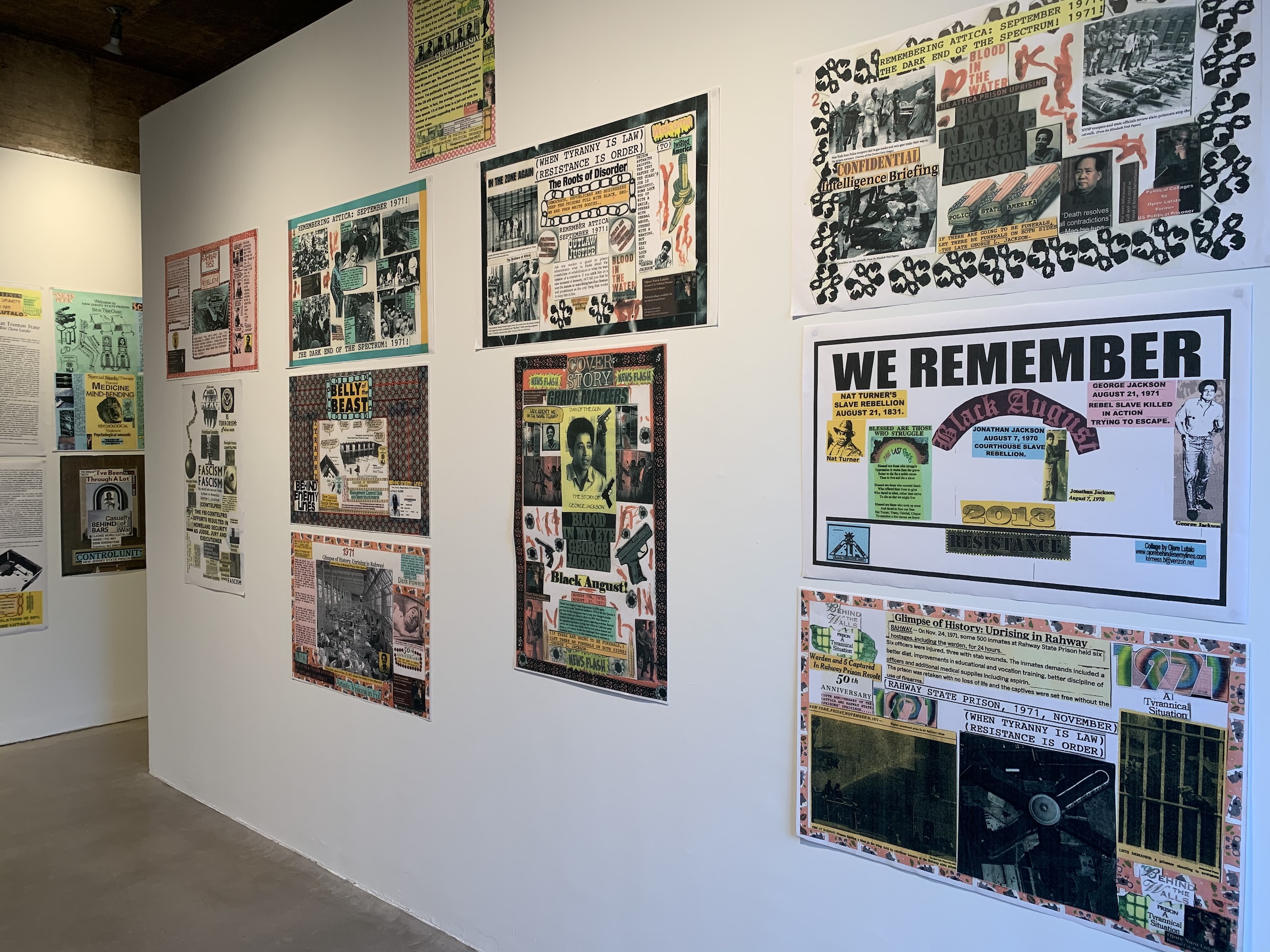Content Warning: this article contains references to violence and police brutality.

The new exhibit at the Ezra and Cecile Zilkha Gallery, “Behind Enemy Lines,” opened this week on Tuesday, September 21. “Behind Enemy Lines” showcases the work of Ojore Lutalo, a formerly incarcerated artist whose protest art offers both his unique perspective on the conditions he faced while imprisoned and commentary on broader carceral culture. Lutalo was present at the opening to give personal tours of the exhibit and explain his experiences to patrons.
The exhibit was curated by Professor and Chair of the Theater Department Ron Jenkins, and is part of “Remembering Attica: Legacy of a Prison Revolt,” a series of Center for the Arts events commemorating the anniversary of the Attica Prison Uprising. The series includes lectures, films, and the premiere performance of a play written by Jenkins himself: “Echoes of Attica.”
Lutalo was released from Trenton State Penitentiary (now the New Jersey State Prison) on August 26, 2009, after spending 28 years in prison on charges of armed robbery and weapons violations. He was also affiliated with anarchist movements and the Black Liberation Army. He spent 22 of his incarcerated years in solitary confinement in the Management Control Unit (MCU). The MCU is a sensory deprivation unit, containing cells roughly the size of an average bathroom. For every 48 hours Lutalo spent in the MCU, 46 were spent in this cage. Prisoners in the MCU are granted few privileges—their telephone use is limited, visitation is controlled, and mail is censored.
“Everything is contained within that cell,” Lutalo said.
Movement outside of the cell is conducted in shackles, accompanied by body searches, and by guards carrying clubs.
The MCU mainly consists of political prisoners such as jailhouse lawyers, revolutionaries, prison unionists, etc. Part of the design was to break people psychologically through isolation, with guards employing techniques Lutalo described as “no-touch” torture. It was ultimately Lutalo’s social and political ideologies, not his crimes, that led to his solitary confinement. Seeing his ideas as dangerous, Trenton State Penitentiary chose to lock Lutalo away from the general prison population along with his beliefs. In his 22 years spent in the MCU, Lutalo was never charged with a single infraction.
Despite this history of captivity and censorship, Lutalo’s spirit, resilience, and voice shine through in his artwork. Consisting of various collages, many of which were created during his time in prison, Lutalo uses photographs, article clippings, and graphics to simultaneously reflect upon his experiences and draw attention to civil rights issues and the brutality within the prison system, especially as it relates to Black prisoners.
One piece centers around the death of Marcia Powell—a 48-year-old prisoner at an Arizona state prison who died in 2009 after being left in an outdoor cage in 108-degree weather. Others focus on Lutalo’s personal encounters in prison and with law enforcement, from being locked in a bloody cell to being wrongfully arrested by Colorado police in 2010.
Referring to the latter experience, Lutalo utilizes an excerpt of a recorded conversation between the two officers who arrested him, in which one officer says, “you should have shot the son of a bitch.” Many pieces highlight racial injustices—touching on police brutality, the parallels between the American prison system and the slave trade, and various significant historical events including the Civil Rights Movement and the Black Panther Party.
Lutalo began to create these collages partially as a way to maintain his sanity and also to illustrate to friends the physical and emotional realities that he was experiencing within his time in solitary confinement.
“In prison, I was always active,” he said. “I had a strong sense of self and purpose.”
Lutalo designed his collages by compiling the headlines, pictures, and graphics from what few catalogs, newspapers, and magazines he was allowed in the MCU. Since no scissors were permitted in his cage, Lutalo folded, tore, and glued the pieces of paper that formed his commentary by hand.
Lutalo’s art is unflinchingly honest in its portrayal of the brutality and injustices occurring within the prison system and our world today. But most of all, Lutalo shows that, despite his experiences, he doesn’t plan to stop fighting for justice anytime soon. He encouraged the crowd to organize against systems of oppression, even if that means arming oneself.
“[The police] understand that language,” he said. “Speak their language and they’ll listen.”
With clippings encouraging audience members to dare to resist, Lutalo’s bold work compels viewers to spark conversations and delve deeper into their own lives–both inside the gallery and out.
“Behind Enemy Lines: The Prison Art of Ojore Lutalo” will be on display Tuesday through Sunday from Noon to 5 pm from September 21, 2021, to October 17, 2021. More information can be found here.
Quinn Canova can be reached at qcanova@wesleyan.edu.
Talia Zitner can be reached at tzitner@wesleyan.edu


Leave a Reply